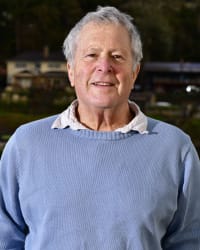The Earth-Watchers
Lawyers in the midst of the environmental fray
Published in 2006 Oregon Super Lawyers magazine
By Scott J. Whitney on November 10, 2006
Oregon has long been a hotbed of environmental discontent. Sometimes this means activists chaining themselves to giant old-growth trees, and sometimes it erupts into something uglier. Lawyers on both sides have always been in the midst of the fray.
Portland attorney Larry Sokol was involved in the fight against aerial spraying of herbicides and pesticides in the 1970s and ’80s. “Illegal actions don’t help the cause,” says Sokol. “I want the court system to work—and for the most part, it does.”
Though he’s more involved these days in plaintiff’s injury and malpractice law, Sokol, a partner at Sokol & Anuta, spent years litigating high-profile environmental cases.
“I feel profoundly blessed to have been able to represent the people I have,” says Sokol, 60. “There was a sea of young activists and scientists who gave enormous amounts of their time to these cases.”
Sokol says the U.S. Forest Service, along with chemical and timber companies, convinced the public that banishing aerial spraying would end timber harvests forever. Loggers, truckers and longshoremen feared impending job losses.
“I had to change my phone number several times,” Sokol recalls. “Phone [callers] to my house and my office threatened to kill me or to kill my family.”
Sokol recalls one dramatic moment from a gypsy moth-spraying case, in which a government scientist testified about risk assessments that must precede such spraying programs.
“I asked him just one question: ‘Show us in the document where it explains how many people will be killed by this spraying program.’”
The flustered scientist replied that, were he back at his Harvard lab, he could do the necessary calculations. This statement was cited by the judge in a nationwide injunction halting the aerial spraying program.
Tom Lindley, a partner at Perkins Coie in Portland, started working in the mid-’80s on Superfund cleanup cases after a law dealing with contaminated areas was passed. Much of the pollution occurred decades earlier.
“Remember,” says Lindley, 58, “we’d just come out of World War II and there was a sense that technology could solve anything: If you’ve got mosquitoes, just spray them. The country was small enough demographically, and large enough geographically, that we could pretend that waste and toxins would just go away.”
In 1993, Lindley helped rewrite the state’s environmental criminal statutes and pioneered the environmental audit, which has been copied by 30 other states. In 2001, he helped write the Oregon Sustainability Act, which required lawmakers to look for ecologically sound solutions.
Martha O. Pagel, at Schwabe, Williamson & Wyatt’s Salem office, served nearly 20 years in state government, including eight years as director of the Oregon Water Resources Department. Her clients now include public utilities, developers, towns and other property owners—all of which need to be shepherded through environmental permitting processes.
The state has been an innovator in water law. Oregon’s State Scenic Waterways Act began life as an initiative in the 1970s, and was designed to protect streams and rivers. Pagel says, “In 1995, we added groundwater to the mix,” because it was discovered that underlying water also affected the flow of waterways. The program lets new users pump groundwater if they perform mitigation, such as buying out an old water right.
Pagel, 52, fondly remembers another landmark date: Nov. 17, 1997. “That’s the date [U.S.] Secretary of the Interior Bruce Babbit flew to Oregon to sign the Warm Springs Treaty Water Rights Settlement Agreement.” Pagel headed up the state’s negotiating team in making amends for Oregon’s failure to deliver on water rights granted in the 1860s to the Confederated Tribes of Warm Springs.
J. Mark Morford, with Stoel Rives, recalls that Oregon was in the forefront of environmental law in the 1970s and ’80s. Things are changing, though, says Morford, 49. “Today, we’re struggling to keep that pioneering role. There’s a kind of pendulum swing, and when enough resistance to regulation develops, the pendulum swings back. Our land-use regulation has been very progressive and constructive, but it’s also created much opposition, especially at the urban boundaries.”
This explains Measure 37, the 2004 voter initiative requiring state and local governments to pay landowners for losses of property value caused by regulations. The governments are still reeling from this year’s state Supreme Court ruling that cleared the way for the law to be implemented.
Still, Morford feels Oregon’s pendulum will swing back to the center. One of the satisfactions of environmental law, he notes, is that the “the stuff we do seems to last.”
Search attorney feature articles
Featured lawyers


Helpful links
Other featured articles
Why Nicole Wells co-founded the Young Breast Cancer Project
Former police officer Caree Harper reps clients in excessive-force police cases
Why CK Hoffler navigates the wild west of name-image-likeness law
Find top lawyers with confidence
The Super Lawyers patented selection process is peer influenced and research driven, selecting the top 5% of attorneys to the Super Lawyers lists each year. We know lawyers and make it easy to connect with them.
Find a lawyer near you

